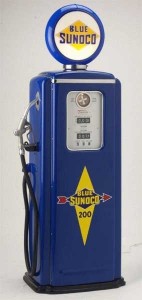
Upgrade to premium and get better mileage? Nope? You're just throwing your money away, says the EPA.
Downsize to a small car, change your air filter every few months, let your cold car warm up before driving off, use premium fuel and aftermarket additives.
These are just some of ways not to improve your fuel economy. Conventional wisdom is often wrong, says the Environmental Protection Agency, which is tasked with tracking and regulating vehicle mileage under the Corporate Average Fuel Economy, or CAFE standards.
Even some of the most knowledgeable enthusiasts and experts may get it wrong when it comes to taking the right steps to improve mileage. In some cases, that’s because of changing technology, the EPA reports on fueleconomy.gov.
In the era of the carburetor, a dirty air filter had a direct and immediate impact on mileage, but “Modern computer-controlled, fuel-injected engines regulate the air-fuel mixture so well that a dirty air filter does not decrease fuel economy—although it can still affect performance,” the EPA notes.
You may also get a surprise when you check the mileage numbers for manual transmissions. Traditionally, sticks did better than automatics, but the latest automatics are lighter and more efficient, with lock-up torque converters that reduce losses, especially at highway speeds. The 2011 Ford Mustang V6 is a notable exampe, rated at 31 mpg Highway with the automatic gearbox, 29 mpg with the manual.
Even downsizing is no guarantee of better. Mustang’s numbers are actually better than a number of smaller cars, and with hybrid or diesel powertrains, some midsize models are outperforming subcompacts.
Here are the Top 10 Misconceptions About Fuel Economy, according to the EPA:
1. You have to drive a small car to get good fuel economy.
2. Manual transmissions always get better fuel economy than automatics.
3. It takes more fuel to start a vehicle than it does to let it idle.
4. Vehicles need to warm up before they can be driven.
5. As a vehicle ages, its fuel economy decreases significantly.
6. Replacing your air filter will help your car run more efficiently.
7. Aftermarket additives and devices can dramatically improve your fuel economy.
8. Using premium fuel improves your fuel economy.
9. The EPA fuel economy estimates are a government guarantee on what fuel economy each vehicle will deliver.
10. All vehicles are tested for fuel economy.
Among the other misconceptions, the government agency notes that idling a cold car only wastes fuel. And while there’s some debate about how long is too long to let your car idle, most studies show that if you’re sitting for more than 15 to 30 seconds you’re better off shutting your car down, then restarting it when it’s time to move.
Indeed, industry officials expect to see so-called Start/Stop technology become near-ubiquitous by the end of this decade. Such systems shut a motor down at idle, say when waiting for a stoplight. The car instantly restarts the moment the driver’s foot lifts off the brake. Start/Stop systems are the norm on hybrids like the Toyota Prius and Honda Insight, but even the new Porsche Panamera has added the technology to its drivetrain.
For the same reason you no longer need to change your air filter all the time, your car should not see its mileage decrease as it gets older. Electronic control systems compensate for the vagaries of aging, though proper maintenance is necessary, especially if you get a warning light indicating a possible problem with one of the engine control systems.
Today’s cars are designed to runon a specific grade of gasoline. You may think you’re being nice to your “baby,” or that using higher octane will somehow improve mileage and performance. It won’t. In fact, many vehicles rated to run on premium can operate on mid-grade or even regular, though that can impact performance. Check your owner’s manual to see what the manufacturer recommends. If it says, “regular no-lead,” you’re only throwing money into the oil company’s bank account by pumping premium.
And as for those additives and high-mileage devices, the simple tip is: forget ‘em. Sure, we’ve all heard about the 100 mpg carburetor and the additive that let’s your car run on water. Lump those stories in with the Loch Ness Monster and the Jersey Devil. In this highly-competitive industry you can be absolutely assured that manufacturers aren’t hiding high-mileage technology. A carmaker that had the 100 mpg carb or fuel injector would bring it out in a heartbeat and dominate the market.
As for those fuel additives, they simply don’t work.
Finally, when it comes to EPA fuel economy estimates, the numbers posted on the Monroney sticker – which you’ll find on the side window of every new car – are just an estimate based on putting the vehicle through a rigorous certification process. Change the test standard even slightly and you’d get a different number. That’s all the more true in the real world, meaning all sorts of things will impact your fuel economy, including your driving habits, traffic, even the altitude you live at.
“Mileage,” goes the old ad tagline, “may vary.” And it usually will.
(You’ll find more from the EPA about mileage myths. Just Click Here.)

Just to point out to all the hybrid doubters, this acceptance of auto start/stop in non hybrid cars by other manufacturers is a direct spin-off of ten years of its use in the Prius and Insight hybrids.
This is not to say they invented the procedure but brought it to fruition and proved its worth.